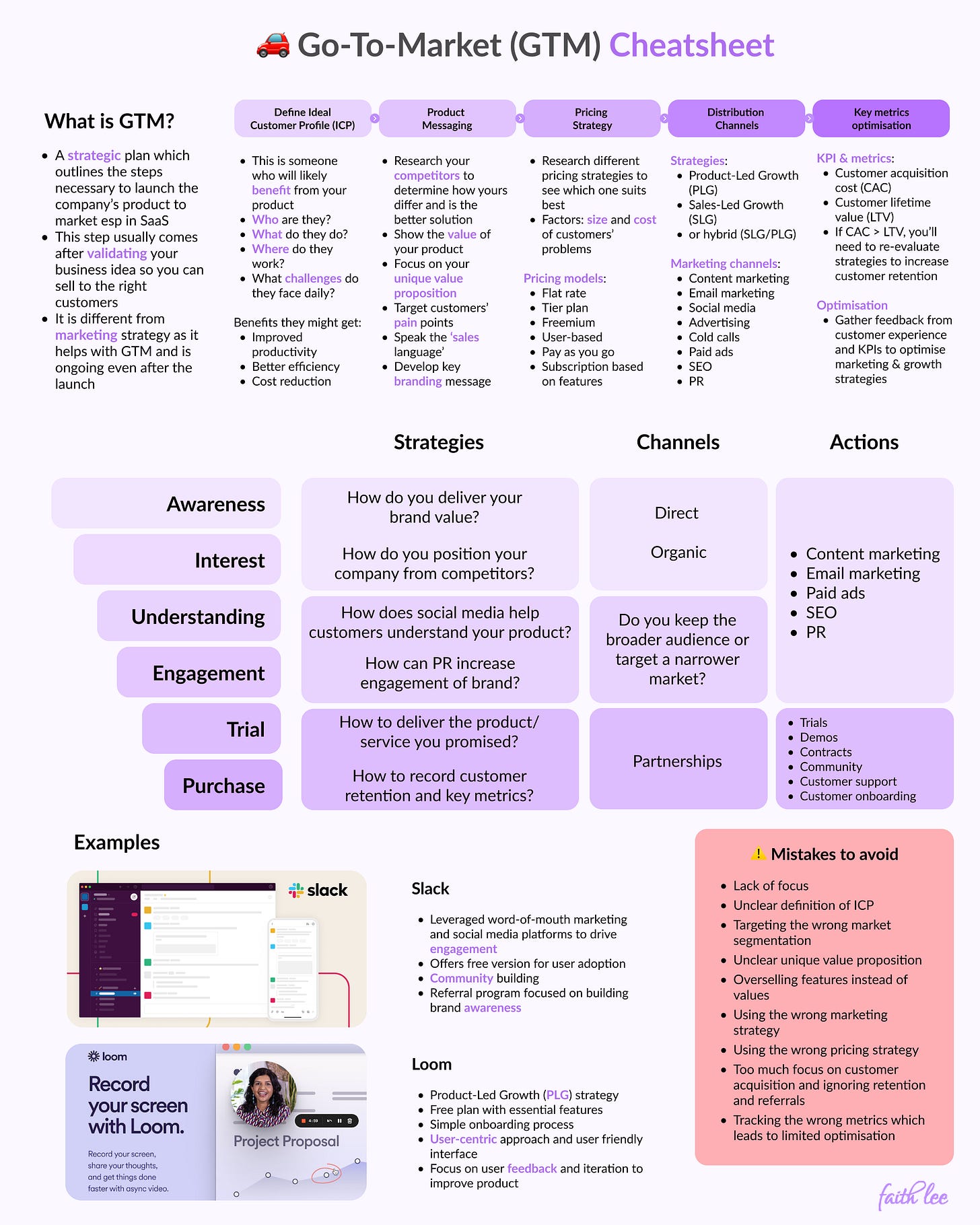The Ultimate Go To Market (GTM) Cheatsheet
Summarises the GTM timeline, giving you the strategies and actions, with examples and mistakes to avoid - all in one place.
The go-to-market (GTM) strategy is probably one of the most important aspects of a business’ roadmap to success. It requires thorough planning and execution to launch a product to the right audience at the right time. Here I summarised some key aspects and insights with guided examples of how businesses can bring their products or services to market effectively.
What is Go-To-Market (GTM)?
A GTM strategic plan helps businesses outline the steps necessary to launch the company’s product to market, especially in SaaS. This step usually comes after validating your business idea so you can sell to the right customers. It is different from marketing strategy as it helps with GTM and is ongoing even after the launch.
Steps for a successful GTM 💯
Define your ideal customer profile (ICP)
Your unique value proposition (UVP)
How to price your products
Your distribution channels
Optimise KPI & metrics
Defining your ideal customer profile (ICP)
Your ideal customer profile (ICP) will be someone who is likely to benefit from your product. The benefits could be improving their productivity, efficiency and reducing costs.
Here are some questions you might want to ask:
Who are they?
What do they do?
Where do they work?
What challenges do they face daily?
Your product messaging
Focus this based on your unique value proposition (UVP). Ask yourself what is the value of your product. Develop the key branding message.
You might want to research your competitors to see how yours differ and why is the better solution. Target your customer’s pain points and ask would you buy your product if you were the customer, and why?
Develop your pricing strategy
Try to research different pricing strategies to see which one best suits your product. Factors you might want to consider are the size and cost of the customers’ problems.
Here are some pricing models:
Flat rate
Tier plan
Freemium
User-based
Pay as you go
Subscription based on features
What are your distribution channels?
You will need to consider different strategies and marketing channels which will help you get the most results and outreach. There is no one-size-fit-all solution. Try to experiment and see which method has the best engagement and optimise to grow the results.
Strategies include:
Product-Led Growth (PLG)
Sales-Led Growth (SLG)
Hybrid (SLG/PLG)
Marketing channels to consider:
Content marketing
Email marketing
Social media
Advertising
Cold calls
Paid ads
SEO
PR
Optimising KPI & metrics
By looking at metrics, you can see which strategy or channels drive the most engagement. Gather feedback from your customers to see how their experience is like. This will help you understand what features of your products you need to iterate and improve.
KPI & metrics to consider:
Customer acquisition cost (CAC): How much it costs a business to get a new customer
Customer lifetime value (LTV): The total amount of money a business expects to make from that customer over the time when they stay with the company
If CAC > LTV, you’ll need to re-evaluate strategies to increase customer retention.
Sales funnel 📈
By understanding the sales funnel from awareness to product purchasing, businesses can apply different strategies to build awareness and interest. With the appropriate actions such as content marketing, paid ads, PR and SEO, companies can maximise their outreach in different distribution channels.
Examples 💡
I’ve included 2 major examples here, featuring Slack and Loom.
Slack is a daily communication tool for businesses. One of the reasons it went viral is because of its ease of use and the power of word-of-mouth marketing. It builds a community and really focuses on the problem it’s solving. This drives huge engagement from users which leads to promotion of brand value and awareness, leading to its success.
Loom is another great example. It leverages a Product-Led-Growth (PLG) strategy, with a simple onboarding process and essential features in its free plan. It focuses on its users and constantly improves through collecting feedback. Talking to your customers is definitely one of the best and most important ways to iterate and improve your product.
How to avoid common mistakes ❌
Focus on values, not just features
Really understand your ideal customer profile
Identify your product messaging and pricing strategy appropriately
Use KPI & metrics to help you identify areas which you can optimise and grow your business
Research your competitors and define your unique value proposition ie. what makes you stand out
The most common pitfall is founders building too many features and not focusing on the customers’ needs
Conclusion
Here is a Linkedin post I wrote about, which summarises the timeline for a GTM plan. I have also included question prompts as a guide for businesses for their sales and marketing funnel. Using examples from Slack and Loom, businesses can be aware of common mistakes and how to avoid them👇

Download the pdf version here 👇
Thank you for reading! If you liked it, share with your friend, family or a fellow founder who might find this useful.
Follow me on Linkedin & Twitter for more updates like this.
What do you think of it?
⭐️⭐️⭐️⭐️⭐️ Love it!
⭐️⭐️⭐️⭐️ It's okay!
⭐️⭐️⭐️ Good
⭐️⭐️ Hmm
⭐️ No
Please let me know if you have any suggestions of what to see next or any feedback! I would value your input.
If you have any interesting articles or stacks, please get in touch! I would love to feature in my next edition! 😇

